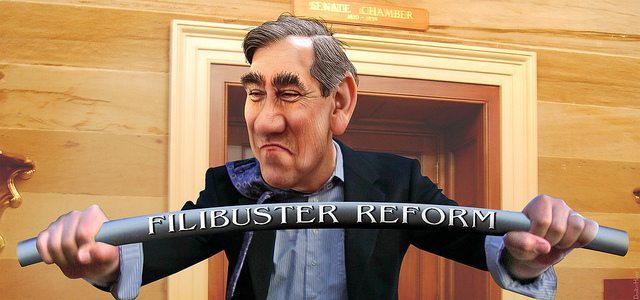 Image courtesy of [DonkeyHotey via Flickr]
Image courtesy of [DonkeyHotey via Flickr]
Politics
The Senate Filibuster: On Its Way Out?
The ability to filibuster has long been an important tool for the United States Senate and some state legislative bodies. But some worry that it leads to unnecessary delay and a stop to productivity. Read on to learn about the development of the filibuster, its uses, and its abuses.
What is a filibuster?
In the Senate the general rule is that a Senator may speak for literally as long as he or she is physically able to do so. When a Senator realizes that his or her position regarding a potential act of Congress is a minority one, the filibuster allows prolonging that debate indefinitely or using other dilatory tactics in order to prevent Congress from voting against that position. Any bill can be subject to two potential filibusters. A filibuster on a motion to proceed to the bill’s consideration, and a filibuster on the bill itself. The typical practical effect of this tactic is that Congress will usually move on to other business for expediency’s sake if a filibuster is threatened on a controversial bill. Filibustering is generally very difficult if the proposed action is not controversial.
However, a filibuster in the U.S. Senate can be defeated by a procedure called cloture. Cloture allows the Senate to end a debate about a proposed action if three-fifths of available Senators concur. After cloture has been initiated, debate on that bill continues for an additional thirty hours with the following restrictions:
- No more than thirty hours of debate may occur.
- No Senator may speak for more than one hour.
- No amendments may be moved unless they were filed on the day in between the presentation of the petition and the actual cloture vote.
- All amendments must be relevant to the debate.
- No other matters may be considered until the question upon which cloture was invoked is disposed of.
This process prevents filibustering from being used by a minimal number of Senators to obstruct bills that the vast majority of Congress wants to pass. However, cloture has drawbacks. It is difficult to implement because it often requires bipartisan support in order to get three-fifths of Senators to vote for it. It also takes time to implement because it must be ignored for a full day after it is presented. Finally, it requires a quorum call before voting so a large enough group of Senators can further delay voting by being absent so that a quorum is no longer present.
One of the most recent filibusters in the US Senate was conducted by Senator Rand Paul (R-KY):
Paul filibustered for nearly 13 hours, which is impressive. The longest Senate filibuster ever recorded was by Strom Thurmond, who filibustered for 24 hours and eighteen minutes.
What’s the argument for getting rid of filibusters?
Proponents of eliminating the Senate’s ability to filibuster argue that filibustering is childish and prevents proper resolution of disagreements about proposed bills. Filibustering allows belligerent legislators to seek acquiescence rather than compromise. When a filibuster is threatened, proponents of a bill may accept amendments to the bill that they do not favor in order to end debate. Even worse, double filibusters can make passing some bills much more time consuming. Moreover, filibusters can create dire consequences for bills that are proposed in time-sensitive circumstances e.g. when the fiscal budget is near expiration and voting is obstructed in order to advance policy interests.
What’s the argument for keeping the ability to filibuster?
Opponents of ending filibustering argue that the maneuver is necessary to preserve the fair representation and consideration of minority views. Without it, a simple majority could pass oppressive restrictions and hardship onto the minority and there would be no recourse against a duly passed law. The filibuster has been used to protect the rights of minorities in this country for a long time. The Senate was designed to ensure that the public’s representation in the decisionmaking process is not entirely controlled by the whims of the majority so that the power dynamic between majority and minority interests did not render the minority intrinsically powerless.
Recent Developments in Filibusters
In 2013, the power of the filibuster hit a road bump. The Senate voted to eliminate the possibility of using the filibuster on federal executive and judicial nominees (excluding Supreme Court nominees). This move was called the “nuclear option,” and it meant that it would just require a simple majority of Senators in order to move forward on confirmation votes. There were many Obama administration appointees stuck in a limbo because they could not get Senate approval.
168 filibusters of nominees in our history. HALF of them have occurred during Obama years! pic.twitter.com/xbQfsftLGm
— Senator Harry Reid (@SenatorReid) November 21, 2013
While the nuclear option was an unprecedented change that will have real effect on the confirmation process for a long time to come, it only affects cloture and filibuster situations in that particular context.
Conclusion
The filibuster has, for many years, played an important role in the American legislative process. But in the United States’ current condition of hyper-partisanship, it may no longer make sense for the filibuster to hold such a strong pull. Filibustering was created to allow the minority to be able to speak on issues that they feel strongly about — but when does the minority abuse that power to take the majority hostage? The Democrats’ 2013 choice to invoke the “nuclear option” may end up being the first in many changes we see to the filibuster moving forward.
Resources
Primary
Additional
Fire Dog Lake: The Filibuster Should be Traded for Eliminating Lifetime Judicial Appointments
Moyers and Company: Larry Cohen on Eliminating the Filibuster
Think Progress: The Filibuster is Bad
Salon: 5 Reasons to Kill the Filibuster
American Prospect: Let’s Shutdown the Filibuster
American Prospect: Don’t Eliminate the Filibuster, Restore It
Real Clear Politics: The Filibuster is a Good Thing
Campaign for Liberty: Filibusters: Good For Restraining Government
Harvard Political Review: In Defense of the Filibuster
Washington Post: Talking Filibusters Are Good For Democracy
How Stuff Works: How a Filibuster Works
Daily Banter: Our Guide to the Filibuster: The Good, the Bad, and the Ugly
Atlantic: If You’d Like a Good, Clean Explanation of the Filibuster Disaster








Comments